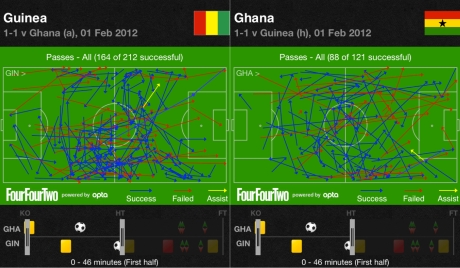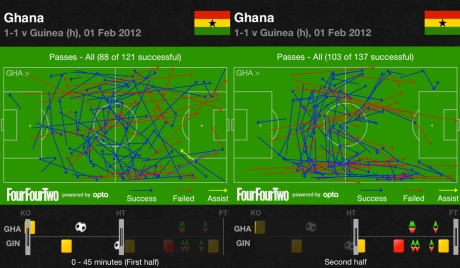Emmanuel Agyemang-Badu’s stunning volley was the shining light in an otherwise underwhelming Black Stars’ performance over Guinea, in Franceville, on Wednesday night.
Ghana coach, Goran Stevanovic, made two changes to the side that beat Mali on Saturday: John Vorsah made a welcomed return, in place of Jonathan Mensah, in the heart of Ghana’s defense; whilst AC Milan’s new signing, Sulley Muntari, was replaced by Samuel Inkoom on the wing.
Guinea coach, Michel Dussuyer, made no changes, keeping faith with the side that thumped Botswana 6-1 in the previous game.
(see the two line-ups below)
A draw or win would see the Black Stars top the group, the National Elephants, on the other hand, needed to win and hope Botswana beat Mali, in Libreville, for them to progress into the Quarter finals.
Guinea made the brighter start to the match, helped in part by Ghana reverting to a more cautious, counter attacking, system. The most striking difference between the two sides’ attacking strategy, in the first half, was their selection of passing from deep areas.
Guinea’s Kamil Zayatte and Bobo Balde rarely looked for long passing options from the back, focusing instead on getting the ball into the feet of Mamadou Bah and Sadio Diallo. Who, in turn, fed the ball into wide areas, particularly the right flank where the lively Ibrahim Traore caused Ghana some early problems.
The Black Stars, on the other hand, focused their passing on short combinations in midfield, before hitting long passes over Kamil Zayatte for Asamoah Gyan to run onto.
(see the diagram below showing the types of passes both sides made in the first half).
Guinea impressed, from an attacking sense, in two key areas. Their accuracy of passing and ball retention, just inside Ghana’s final third, was far better than that of their opponents. Allied to this, the speed of their midfield, in the transition from defense to attack, gave them more short passing options in the attacking third.
The Badu influence
On twenty eight minutes, against the run of play, Ghana’s Emmanel Agyemang-Badu broke the deadlock with a stunning 20 yard volley.
The lively, twenty one year old, Udinese midfielder is fast becoming an influential player for the Black Stars. SuperSport correspondent, Gary Al-Smith, voted Badu as ‘Man of the Match’ against Mali and the youngster produced yet another impressive display against Guinea on Wednesday night.
His cause was aided and abetted by the presence of Pascual Feindouno, as his opposite number, in Guinea’s midfield. For all Feindouno’s excellent trickery and linkup play in the attacking third, he’s the least able (of Guinea’s midfield three) to recovery quickly into a defensive position, when his side lose the ball in the attacking half. This key area, vacated by Feindouno in the transition, provided Badu with time and space to make driving runs forward, in support of Andre Ayew and Asamoah Gyan.
It’s also worth nothing, that the young midfielder made almost double the number of passes (43) that his supporting midfielders, Kwadwo Asamoah (22) and Anthony Annan (23), attempted.
(see below his passing stats and player dashboard)
With the pre-tournament chatter concerning Michael Essien’s latest return to Chelsea’s first team, following his recovery from injury. The question has to be asked; if Badu continues to perform so well, is Essien needed?
Pinpointing Pantsil
Guinea’s Pascal Feindouno, Mamadou Bah and Sadio Diallo struggled to break through Ghana’s tight, central midfield, unit. And with loan striker, Ismael Bangoura, a peripheral figure upfront, the only real avenue Guinea had to try and get beyond Ghana’s defensive line was by utilising their wingers.
Ibrahim Traore made a lively start on the right, but faded badly after his side went behind. This was partly down to Goran Stevanovic reading the problem and instructing Ghana’s left back, Masahudu, to sit deeper and curtail Traore’s forward runs.
So, with Traore denied space on the right, more emphasis had to be placed on picking out Abdoul Camara on the left flank. With Ghana’s evergreen, John Pantsil, making his customary driving runs down the right, into the space created by Andre Ayew cutting in from the flank, Guinea could have capitalise on the space behind him, providing they could get quick, quality, passes into the live-wire Camara. Sadly, for National Elephants’ fans, more often than not, their passes out to the left were slow and inaccurate.
With half time rapidly approaching, Carmara finally got a decent pass to feet, dropped his shoulder, sped past Pantsil and swept in a cross that, rather fortuitously, evaded Ghana keeper, Kwarasey, and looped into the far corner of the Black Stars’ net.
From a Ghanaian perspective, the jury must still be out on whether Panstil deserves a starting place at right back, ahead of Samuel Inkoom or Daniel Opare. For all his undoubted qualities as a leader and guiding figure to the younger players in the Ghanaian team, the few occasions the Black Stars have looked exposed in this tournament have been from attacks springing from his area of the pitch.
Asamoah Gyan
Ghana’s star striker continues to look out of sorts up front. Granted he is recovering from a hamstring injury and, in this match, faced one of the tournament’s most imposing central defensive partnerships, in Zayatte and Balde. But, with Ghana so reliant on him to provide a focal point in the attacking half, coach Stevanovic must be concerned at how labored his star striker continues to look.
An on-form Gyan does two things exceptionally well. Firstly, he isolates himself with an opposition centre back, before making darting runs between him and their full backs. And, secondly, his positive movement, drive and energy, helps draws in his fellow forwards and midfield runners, who he can combines with.
In the first half, he isolated himself with Zayatte. As we touched upon earlier, Ghana’s attacking approach, in the first forty five minutes, was to hit long, quick, passes from defense, to try and get Gyan 1v1 with Zayatte. It didn’t work, and the Ghanaian frontman lost the first half battle with Zayatte.
In the second half, Ghana’s passing approach changed and, realising they were making no progress with long balls for Gyan to chase, made a concerted effort to play around their opponents.
(see the diagrams below showing the difference in the types of passes made by Ghana in the second half compared with the first).
Gyan also changed his approach, now drifting across to the right and taking up a position closer to Bobo Balde. But the Ghanaian striker continued to look slow off the mark, compared to the former Celtic defender and was, unsurprisingly, substituted with fifteen minutes remaining.
Of the four goals Ghana have scored so far at this year’s Africa Cup of Nations, three have come from set pieces. Breaking down Ghana’s defensive unit will pose a real challenge for Tunisia, but the Black Stars’ continuing lack of attacking thrust, in open play, must surely be a concern for their coach and fans, as they approach the quarter finals.



